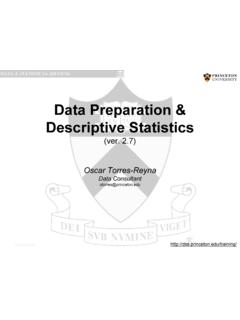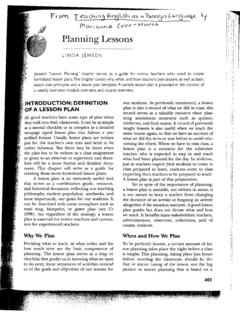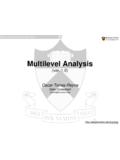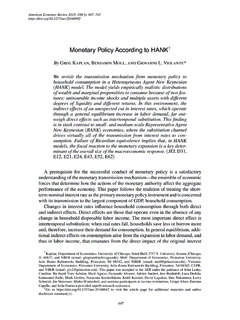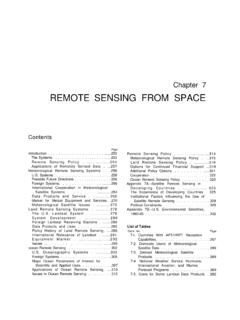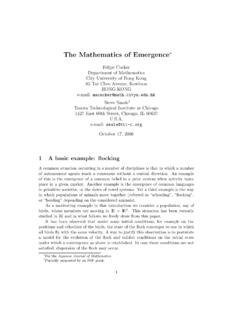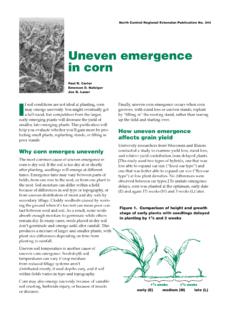Transcription of MASS POLITICAL MOBILIZATION - Princeton University
1 Part & Stokes: The Oxford Handbook of Comparative PoliticsBoixandstokes-chap21 Revise Proofpage497 12:41pmBoix & Stokes: The Oxford Handbook of Comparative PoliticsBoixandstokes-chap21 Revise Proofpage498 12:41pmchapter EMERGENCEOF PARTIES ANDPA RT Y S YS T E M boixWiththe exception of a few Swiss cantons where all voters assemble in annualassemblies orLandsgemeindeand some New England towns where neighbors debateand vote in open meetings, all contemporary democracies are representative democra-cies. Direct democracy is simply impractical in today s world. States are too large interritory and population for a sizeable fraction of the citizenry to debate together anddirectly any POLITICAL question at hand in a meaningful, sustained manner. The rangeand complexity of most issues that fall under public consideration is such that no citizencan master them even if she were to invest all her time in politics.
2 As in the sphere ofeconomic life, where agents work and produce in a highly specialized manner, contem-porary politics has given way also to the idea of division of labor in all its of deciding directly, voters choose, through regular elections, a number ofpoliticians to set policy and govern them. In other words, they fully delegate thepower to make decisions and to supervise those decisions to their representatives fora given period of time, that is, until new elections are held. In turn, those future electionsare roughly the only, albeit probably imperfect, mechanism to discipline policy makersto act on behalf of the voters very scale of contemporary polities and the electoral and parliamentary dynamicsof representative democracies have in turn prompted politicians to create or joinelectoral and legislative teams or parties, that is, stable organizations through whichpoliticians coordinate their POLITICAL activity across electoral districts, in parliamentaryassemblies, and in executive or governmental committees.
3 In the parliamentary arena theBoix & Stokes: The Oxford Handbook of Comparative PoliticsBoixandstokes-chap21 Revise Proofpage499 12:41pmcoordination in parties reduces the transaction costs associated with crafting and passinglaws. Moreover, partisan coordination probably enhances the ability of the legislature tohold the executive accountable. In the electoral arena, parties can gather and employ in amore eYcient manner theWnancial and human resources politicians need to inform andmobilize voters. By easing the process of candidate selection and forcing the strategiccoordination of voters on their members, they increase their electoral odds of , the creation of a pattern of stable cooperation among some legislators shouldconfer on them a clear advantage over their opponents in terms of presenting a stableprogram and of defending their record in a clear-cut manner before , POLITICAL parties are a pervasive phenomenon in representative dem-ocracies.
4 Factional coordination or the stable cooperation of POLITICAL representativescame into being shortly after the formation of theWrst modern assemblies: in the UnitedStates since the1780s, in France in theWrst year of the French Revolution, in Britainthrough the opposition of Tories and Whigs. As the electorate expanded and electionsbecame clean and truly competitive mechanisms of selection, those factions developedinto gradually more cohesive machines disciplining their members in favor or againstthe government, presenting voters with a uniWed program, and taking care to bringvoters to the ballot box. Modern parties, as both electoral and legislative machines,emerged in the late1820s and early1830s in Jacksonian America. In Belgium andSwitzerland uniWed Liberal (or Radical) parties were founded in the late1840s. InBritain, LiberalsWnally cohered as a parliamentary party in the1850s. By the1880sboth they and the Conservatives were uniWed national organizations for all purposes.
5 Inthe last third of the nineteenth century Catholics and social democrats launched highlycentralized, mass parties in continental Europe. By the time the First World War startedalmost all electoral contests and parliamentary struggles pivoted around well-organizedparties in all representative The Question: What Parties?Which Party Systems?..Although the coordination of politicians into parties, that is, into vote-seeking andgoverning teams of candidates and parliamentarians, has been a universal, almostlawlike phenomenon in contemporary democracies, the ways in which politicianshave organized and voters have responded to partisan appeals have varied widelyover time and across countries. On the one hand, POLITICAL parties diVer in theirinternal architecture: how hierarchical they are; the strength of their parliamentarywing vis-a`-vis the party apparatus; the number, extraction, and commitment of their1 The functions performed by parties were extensively discussed in the sociological and structuralliterature of the1960s and1970s (LaPalombara and Weiner1966; Sartori1976).
6 This research was recast inrational and institutional terms, which I follow here, in the1990s (Cox and McCubbins1993; Aldrich1995).Boix & Stokes: The Oxford Handbook of Comparative PoliticsBoixandstokes-chap21 Revise Proofpage500 12:41pm500carles boixmembership; or their cohesiveness, ranging from loose, almost ad hoc coalitions ofinterests, to tightly disciplined organizations whose members never deviate from theoYcial position of the party (Duverger1954; Panebianco1988).On the other hand, parties vary in their external dimension or attributes, that is, intheir articulation in the electoral market. First, they diverge in their ideologicalorientation and their programmatic goals in other words, they diVer in the set ofpromises they make to electors and, constrained by world conditions, in the decisionsthey , they diVer in the size of their electoral support and parliamentaryrepresentation as well as in the stability with which they hold their programmatic stance of any party and, to a lesser degree, its electoral strengthare a function of the choices made by its members about which goals they will pursueand how they should advance them.
7 But the electoral support of any party dependsalso on the ideological commitments and POLITICAL strategies adopted by otherpolitical competitors in two ways. First, parties draft their electoral platforms partlyin response to the programmatic (and policy) choices other parties make on issuessuch as the provision of public goods, the control of education, and the conduct offoreign policy. Second, voters eventually vote on the basis of the alternative positionstaken by the diVerent parties in the electoral market. In other words, both the sizeand the POLITICAL stance of parties are the outcome of the strategic interaction ofdiVerent politicians and their organizations in their quest for electoral success. Fromthis point of view, it then makes sense to talk about the system of parties or partysystem in any country that is, about the national proWle, in terms of number, size,and ideological preferences, of the following section I summarize the two main competing explanations ofparty systems, the historical-sociological literature and the neo-institutionalistresearch agenda, and evaluate their strengths and limitations.
8 In the next two sectionsI then suggest a method of restructuring the way in which we should think howparties emerged that integrates, in a broad analytical framework, both Current Theoretical AccountsIn a path-breaking study published in1967, Lipset and Rokkan emphasized the hetero-geneity of interests and social groups to explain the emergence of diVerent party systems inWestern Europe in the nineteenth and early twentieth centuries (Lipset and Rokkan1967).2A recent and important strand of literature distinguishes today between (strictly) programmatic andclientelistic parties (Kitschelt et ;Stokes2005). Here I do not make this distinction I take clientelistic parties to have as their program the distribution of particularistic goods to their of this section relies heavily on Boix (2006b).Boix & Stokes: The Oxford Handbook of Comparative PoliticsBoixandstokes-chap21 Revise Proofpage501 12:41pmemergence of parties and party systems501 More speciWcally, they claimed that the number and relative strength of diVerent partiesacross European nations was determined by two crucial historical events: a nationalrevolution, that is, the construction of modern, secular nation-states; and the industrialrevolution.
9 As the state elites engaged in the construction of a single administrativeapparatus, a centralized bureaucracy and a national standardized culture, they faced theresistance of two social groups the members of territorial peripheries that opposedthe process of centralization and the Catholic Church, which was in danger of losingits properties, educational structures, and in some instances its direct inXuence overstate policy. In turn, the industrial revolution, with the emergence of manufacturingWrms and the parallel growth of cities, generated two additional dimensions of conXict:between countryside and cities (mostly around trade policy) and, within the latter,between the owners of capital and capital labor conXict eventually emerged in all countries and acquired fullpolitical signiWcance with the full extension of universal suVrage. By contrast, thespeciWc nature and the strength of the other three kinds of conXict (territorial,religious, and rural urban) varied across Europe (and, by default, although Rokkanand Lipset do not treat them, in the former settler colonies governed throughdemocratic institutions).
10 The type of POLITICAL parties that formed varied acrosscountries as a function of those dimensions of conXict. To name a few examples,religious conXict was considerable in most Catholic countries as well as in thosecountries where there was a signiWcant Catholic majority. But it was fundamentallyabsent in Scandinavia. Trade policy played a central role in the latter and in mostlarge states but not in countries such as Belgium or the addition to the variation in the nature and size of social interests, party systems werealso shaped by the sequence of alliances made by the POLITICAL elites (and counter-elites)of each country. In those countries where the Reformation triumphed and the statecontrolled the national Protestant Church, the central conXict hinged around tradeissues and the opposition of land versus town. In Britain landholders and the establishedChurch coincided in the Conservative Party against a Liberal Party based on urbaninterests and Nonconformist Protestants.
